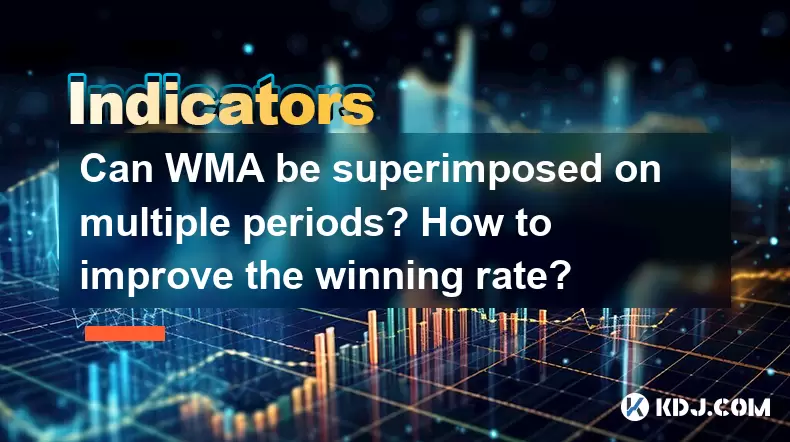-
 bitcoin
bitcoin $109523.663807 USD
-0.13% -
 ethereum
ethereum $4019.526508 USD
2.06% -
 tether
tether $1.000482 USD
0.00% -
 xrp
xrp $2.776815 USD
0.18% -
 bnb
bnb $958.942396 USD
0.12% -
 solana
solana $204.294698 USD
3.84% -
 usd-coin
usd-coin $0.999693 USD
0.00% -
 dogecoin
dogecoin $0.232115 USD
2.09% -
 tron
tron $0.338028 USD
0.84% -
 cardano
cardano $0.790920 USD
1.50% -
 hyperliquid
hyperliquid $44.871443 USD
5.60% -
 ethena-usde
ethena-usde $1.000322 USD
0.04% -
 chainlink
chainlink $21.034165 USD
2.60% -
 avalanche
avalanche $28.794831 USD
-0.54% -
 stellar
stellar $0.360466 USD
1.24%
Can WMA be superimposed on multiple periods? How to improve the winning rate?
WMA, a key crypto trading tool, can be superimposed on multiple time frames to enhance trend analysis and improve trading decisions.
May 21, 2025 at 02:57 pm

Understanding WMA and Its Application in Cryptocurrency Trading
The Weighted Moving Average (WMA) is a popular technical indicator used by traders in the cryptocurrency market to make informed decisions. Unlike the simple moving average, WMA assigns more weight to recent price data, making it more responsive to new information. This feature is particularly useful in the volatile cryptocurrency markets where rapid price changes are common.
In the context of cryptocurrency trading, WMA can be used to identify trends, potential reversals, and to generate buy or sell signals. The key to using WMA effectively lies in understanding how to apply it across multiple time periods and how to enhance the accuracy of trading decisions based on this indicator.
Can WMA be Superimposed on Multiple Periods?
Yes, WMA can be superimposed on multiple periods. This technique allows traders to analyze the market from different time frames simultaneously, providing a more comprehensive view of the market dynamics. By overlaying WMAs of different periods, traders can identify short-term fluctuations within a long-term trend, enhancing their ability to make strategic trading decisions.
To superimpose WMAs on multiple periods, traders can follow these steps:
- Choose the time frames: Decide on the different time frames you want to analyze, such as 5-minute, 15-minute, 1-hour, and 4-hour charts.
- Calculate WMAs for each period: Use a trading platform or charting software to calculate the WMA for each chosen time frame. Ensure that the weights assigned to recent prices are consistent across all periods.
- Overlay the WMAs: Plot the WMAs on the same chart, using different colors or line styles to distinguish between them. This visual representation helps in identifying crossovers and divergences that may not be apparent when looking at a single period.
By analyzing the intersections and divergences of these WMAs, traders can gain insights into the market's direction and momentum, improving their decision-making process.
How to Improve the Winning Rate Using WMA
Improving the winning rate in cryptocurrency trading using WMA involves a combination of technical analysis, risk management, and continuous learning. Here are some strategies to enhance your trading performance:
Combining WMA with Other Indicators
Using WMA in conjunction with other technical indicators can provide a more robust trading strategy. For instance, combining WMA with the Relative Strength Index (RSI) or Moving Average Convergence Divergence (MACD) can help confirm signals and reduce false positives.
- WMA and RSI: When the WMA indicates a bullish trend and the RSI is above 50, it may signal a strong buying opportunity. Conversely, a bearish WMA trend combined with an RSI below 50 could indicate a good time to sell.
- WMA and MACD: A bullish crossover in the MACD, accompanied by a rising WMA, can confirm a bullish trend. Similarly, a bearish MACD crossover with a falling WMA can confirm a bearish trend.
Backtesting Your WMA Strategy
Backtesting is a crucial step in refining your trading strategy. By applying your WMA-based strategy to historical data, you can assess its effectiveness and make necessary adjustments.
- Select a historical period: Choose a period that reflects various market conditions, including bull and bear markets.
- Apply your WMA strategy: Use trading software to apply your WMA strategy to the historical data, noting the entry and exit points.
- Analyze the results: Calculate the win rate, average profit, and average loss. Identify patterns and adjust your strategy to improve performance.
Implementing Risk Management
Effective risk management is essential for improving the winning rate. This includes setting stop-loss orders, managing position sizes, and diversifying your portfolio.
- Stop-loss orders: Set stop-loss orders to limit potential losses. For example, if you enter a trade based on a WMA signal, set a stop-loss at a level that aligns with your risk tolerance.
- Position sizing: Adjust your position size based on the volatility of the cryptocurrency and your overall risk exposure. Smaller positions in highly volatile markets can help manage risk.
- Diversification: Spread your investments across different cryptocurrencies to reduce the impact of a single asset's performance on your portfolio.
Continuous Learning and Adaptation
The cryptocurrency market is dynamic, and what works today may not work tomorrow. Continuous learning and adaptation are key to maintaining and improving your winning rate.
- Stay informed: Keep up with market news, regulatory changes, and technological developments that may impact cryptocurrency prices.
- Analyze your trades: Regularly review your trading performance, noting what worked and what didn't. Use this information to refine your WMA strategy.
- Experiment with different time frames: Test your WMA strategy on different time frames to find the one that best suits your trading style and market conditions.
FAQs
Can WMA be used for all cryptocurrencies?
Yes, WMA can be applied to any cryptocurrency. However, the effectiveness of WMA may vary depending on the liquidity and volatility of the specific cryptocurrency. For highly volatile assets, shorter time frames may be more appropriate, while less volatile assets might benefit from longer time frames.
How often should I adjust my WMA settings?
The frequency of adjusting WMA settings depends on the market conditions and your trading strategy. In highly volatile markets, you may need to adjust your WMA settings more frequently to stay aligned with current trends. Conversely, in more stable markets, less frequent adjustments may be sufficient.
Is WMA suitable for both short-term and long-term trading?
Yes, WMA can be used for both short-term and long-term trading. For short-term trading, shorter time frames such as 5-minute or 15-minute charts are typically used, while for long-term trading, longer time frames like 4-hour or daily charts are more appropriate. The key is to align the WMA settings with your trading objectives and time horizon.
Can WMA be used in conjunction with fundamental analysis?
While WMA is primarily a technical indicator, it can be used in conjunction with fundamental analysis to enhance trading decisions. Fundamental analysis can provide insights into the intrinsic value of a cryptocurrency, while WMA can help identify the best entry and exit points based on market trends. Combining both approaches can lead to a more holistic trading strategy.
Disclaimer:info@kdj.com
The information provided is not trading advice. kdj.com does not assume any responsibility for any investments made based on the information provided in this article. Cryptocurrencies are highly volatile and it is highly recommended that you invest with caution after thorough research!
If you believe that the content used on this website infringes your copyright, please contact us immediately (info@kdj.com) and we will delete it promptly.
- Ethereum Price Crash Concerns: Navigating the Volatility
- 2025-09-27 16:45:11
- Bitcoin's Bull Flag and FVG: Decoding the Crypto Crystal Ball
- 2025-09-27 16:25:14
- Ozak AI's $OZ Token: Riding the AI & Blockchain Profit Surge
- 2025-09-27 16:25:14
- Remittix Token Presale: CertiK Verification and PayFi Innovation
- 2025-09-27 16:30:00
- XRP Chart Signal Sparks Price Rally Buzz: Is a Breakout Imminent?
- 2025-09-27 16:45:11
- Vitalik, Chat Control, and Privacy Security: A Balancing Act
- 2025-09-27 16:30:00
Related knowledge

What is a tower bottom candlestick pattern? Does it have a high success rate?
Sep 22,2025 at 07:18am
Tower Bottom Candlestick Pattern Explained1. The tower bottom candlestick pattern is a reversal formation that typically appears at the end of a downt...

What is a black hole pattern in the MACD indicator? Is it a cause for concern?
Sep 21,2025 at 06:54pm
Bitcoin's Role in Decentralized Finance1. Bitcoin remains the cornerstone of decentralized finance, serving as a benchmark for value and security acro...

How can I use the psychological line (PSY) to determine market sentiment?
Sep 17,2025 at 02:19pm
Understanding the Psychological Line (PSY) in Cryptocurrency TradingThe Psychological Line, commonly referred to as PSY, is a momentum oscillator used...

How can I determine if a double top pattern has officially formed?
Sep 21,2025 at 03:18am
Understanding the Structure of a Double Top Pattern1. A double top pattern consists of two distinct peaks that reach approximately the same price leve...

What is the Golden Valley pattern on the moving average? Is it better than the Silver Valley pattern?
Sep 21,2025 at 02:54pm
Understanding the Golden Valley Pattern in Moving Averages1. The Golden Valley pattern is a technical formation observed in cryptocurrency price chart...

What does a death cross of the RSI in the strong zone (above 50) mean?
Sep 17,2025 at 10:54pm
Understanding the Death Cross in RSI Context1. The term 'death cross' is traditionally associated with moving averages, where a short-term average cro...

What is a tower bottom candlestick pattern? Does it have a high success rate?
Sep 22,2025 at 07:18am
Tower Bottom Candlestick Pattern Explained1. The tower bottom candlestick pattern is a reversal formation that typically appears at the end of a downt...

What is a black hole pattern in the MACD indicator? Is it a cause for concern?
Sep 21,2025 at 06:54pm
Bitcoin's Role in Decentralized Finance1. Bitcoin remains the cornerstone of decentralized finance, serving as a benchmark for value and security acro...

How can I use the psychological line (PSY) to determine market sentiment?
Sep 17,2025 at 02:19pm
Understanding the Psychological Line (PSY) in Cryptocurrency TradingThe Psychological Line, commonly referred to as PSY, is a momentum oscillator used...

How can I determine if a double top pattern has officially formed?
Sep 21,2025 at 03:18am
Understanding the Structure of a Double Top Pattern1. A double top pattern consists of two distinct peaks that reach approximately the same price leve...

What is the Golden Valley pattern on the moving average? Is it better than the Silver Valley pattern?
Sep 21,2025 at 02:54pm
Understanding the Golden Valley Pattern in Moving Averages1. The Golden Valley pattern is a technical formation observed in cryptocurrency price chart...

What does a death cross of the RSI in the strong zone (above 50) mean?
Sep 17,2025 at 10:54pm
Understanding the Death Cross in RSI Context1. The term 'death cross' is traditionally associated with moving averages, where a short-term average cro...
See all articles










































































